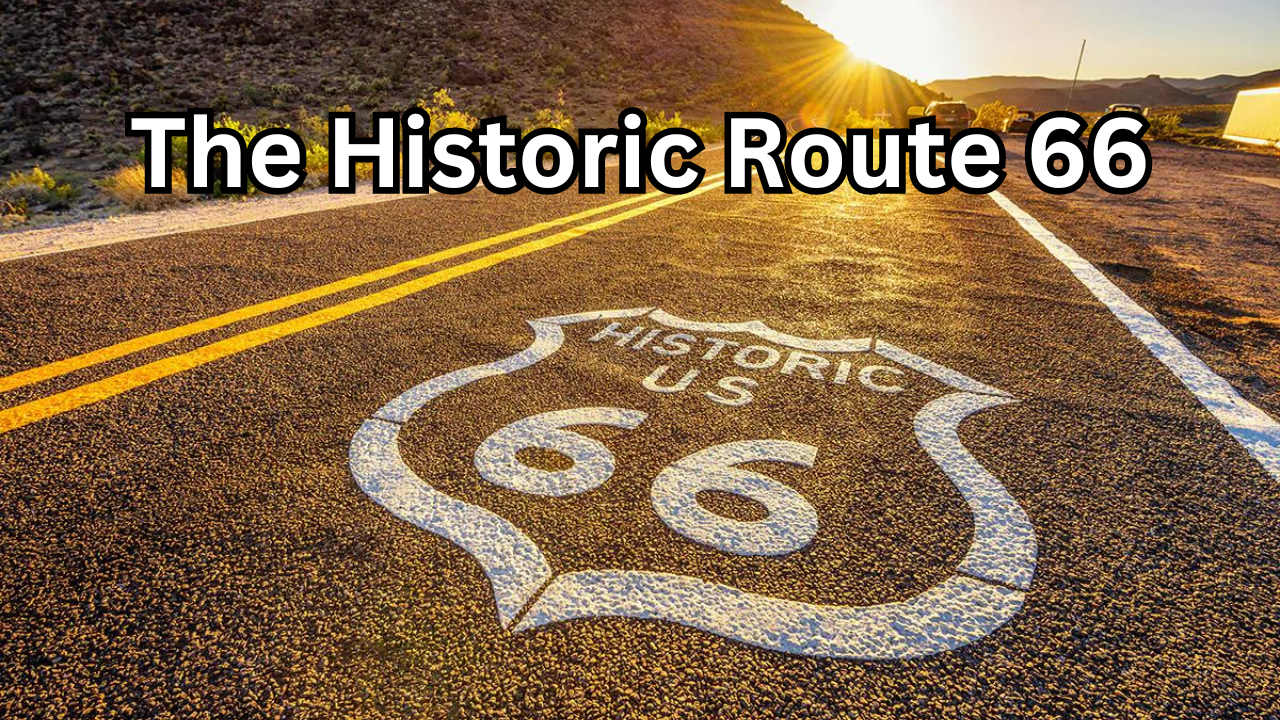Table of Contents
Introduction to Route 66
The introduction to Historic Route 66 sets the stage for exploring its rich history and cultural significance as a quintessential American road. Established in 1926, Route 66 originally connected Chicago, Illinois, to Santa Monica, California, spanning over 2,400 miles across eight states. Often referred to as the “Main Street of America” or the “Mother Road,” Route 66 played a pivotal role in American history, facilitating westward migration during the Dust Bowl era and serving as a vital artery for commerce and travel.
Today, while much of Route 66 has been replaced by modern highways, it remains a symbol of adventure and nostalgia, dotted with iconic diners, neon-lit motels, and roadside attractions that harken back to mid-20th-century Americana. Exploring Route 66 offers a glimpse into the past, showcasing diverse landscapes, cultural influences, and the enduring spirit of exploration that defines the American experience.
Brief History and Significance of Historic Route 66
Route 66, established in 1926, holds a significant place in American history as one of the country’s earliest highways. Originally intended to link rural and urban communities, it quickly became a symbol of hope and opportunity during the Great Depression. Stretching from Chicago, Illinois, to Santa Monica, California, this route played a crucial role in the migration westward, particularly during the Dust Bowl era of the 1930s, offering escape and economic prospects to thousands seeking a better life.
Overview of its Route from Chicago to Santa Monica
Route 66 winds its way through a diverse tapestry of landscapes and cultures across eight states: Illinois, Missouri, Kansas, Oklahoma, Texas, New Mexico, Arizona, and California. Starting in Chicago, the route passes through the heartland of America, traversing rolling plains, bustling cities, and historic small towns. It cuts through the Southwest, showcasing rugged deserts, mesas, and iconic natural landmarks like the Grand Canyon. Finally, it culminates in Santa Monica, where the Pacific Ocean beckons travelers at the end of their journey along this iconic stretch of American road.
Route 66 Through Illinois\
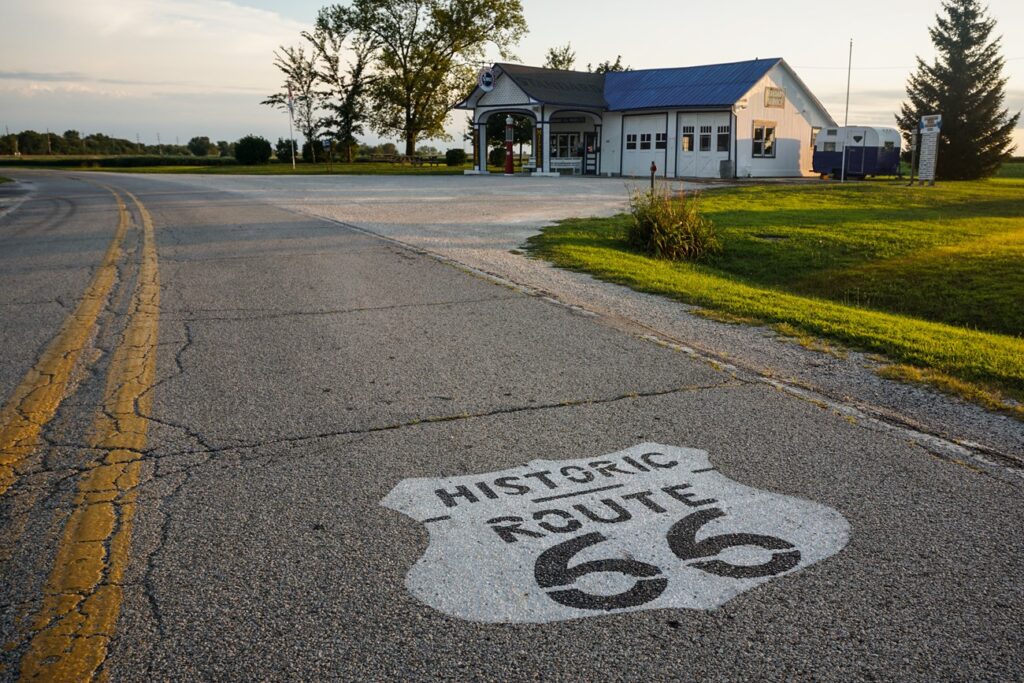
Landmarks and Attractions in Illinois
Route 66 enters Illinois from the east, marking the beginning of its journey westward. This segment spans approximately 300 miles through the state, offering travelers a glimpse into both urban and rural landscapes.
- Chicago: As the starting point of Route 66, Chicago boasts several iconic landmarks related to the route, including the Art Institute of Chicago, Grant Park, and Millennium Park.
- Joliet: Known for its historic Route 66 Welcome Center and the Route 66 Park, Joliet offers a nostalgic glimpse into the road’s early days.
- Pontiac: Pontiac is home to the Route 66 Hall of Fame and Museum, showcasing memorabilia and artifacts that highlight the history and culture of the route.
- Springfield: Illinois’ state capital, Springfield, features attractions like the Illinois State Capitol, the Abraham Lincoln Presidential Library and Museum, and the Cozy Dog Drive-In, a Route 66 landmark famous for inventing the corn dog.
- Other Highlights: Along the way, travelers can also explore historic alignments of the route, charming small towns, and roadside diners that evoke the spirit of mid-20th-century America.
Historical Significance of this Segment
The Illinois segment of Route 66 holds immense Historical Tour significance as the starting point of the route. During the early 20th century, this stretch facilitated the movement of goods and people between the industrial Midwest and the burgeoning West. It became a symbol of economic vitality and expansion, offering hope and opportunity to those seeking new beginnings during periods of economic hardship, such as the Great Depression and the Dust Bowl era. Today, Illinois continues to preserve and celebrate Route 66’s legacy through museums, historic sites, and events that attract travelers from around the world, honoring its role in shaping American culture and identity.
Missouri: The Gateway to the West
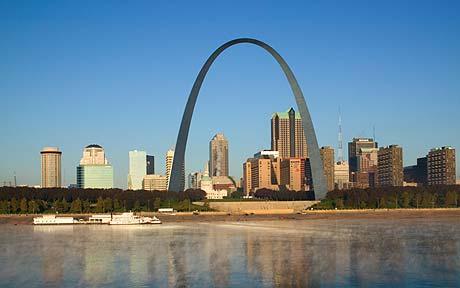
Missouri marks an important segment along Route 66, often referred to as the “Gateway to the West.” This designation reflects its historical significance as a launching point for westward expansion during the 19th century and its pivotal role in the development of the American frontier.
Key Stops and Sights in Missouri
- St. Louis: As Missouri’s largest city, St. Louis offers several attractions along Route 66, including the Gateway Arch, which symbolizes the westward expansion of the United States. Visitors can also explore the Old Chain of Rocks Bridge, a historic Route 66 crossing over the Mississippi River.
- Meramec Caverns: Located near Stanton, Meramec Caverns are a popular tourist attraction known for their natural beauty and extensive cave formations. They have been a draw for travelers on Route 66 since the route’s heyday.
- Route 66 State Park: Situated in Eureka, this park preserves a section of the original roadbed of Route 66 and offers hiking trails, picnic areas, and historical exhibits that highlight the route’s significance.
- Lebanon: Known as the “Home of the Munger Moss Motel,” Lebanon boasts a well-preserved section of Route 66, along with vintage diners and motels that provide a glimpse into the road’s nostalgic past.
- Springfield: Missouri’s Springfield features attractions such as the Gillioz Theatre, a historic movie palace, and the Birthplace of Route 66 Festival, celebrating the route’s history and impact on the region.
Cultural Impact on the State
Route 66 had a profound cultural impact on Missouri, influencing its development as a crossroads of commerce, culture, and transportation. The route facilitated economic growth by connecting Missouri’s rural communities to larger markets in both the Midwest and the West Coast. It brought tourists and travelers from across the country, fostering a vibrant hospitality industry that included roadside motels, diners, and gas stations.
Moreover, Route 66 became a symbol of freedom and adventure, embodying the American spirit of exploration and mobility. Its cultural influence is evident in Missouri’s preservation efforts, with communities along the route actively preserving historic landmarks and promoting tourism related to Route 66 nostalgia. Today, Route 66 continues to be celebrated in Missouri through festivals, museums, and events that honor its role in shaping the state’s identity and connecting it to the broader tapestry of American history.
Kansas and Oklahoma: Heartland Landscapes

Kansas and Oklahoma form a significant portion of Route 66 through America’s heartland, showcasing expansive landscapes, small-town charm, and rich historical narratives.
Highlights of These States Along Route 66
- Kansas:
- Galena: Known for its mining history and vintage car culture, Galena is home to the “Cars on the Route” diner, featuring the iconic Tow Mater truck from the animated film “Cars.”
- Baxter Springs: A historic town with remnants of the Old Military Trail and the famous Rainbow Bridge, a Marsh Arch bridge on Route 66.
- Oklahoma:
- Tulsa: This vibrant city along Route 66 offers attractions like the Cyrus Avery Route 66 Memorial Bridge and the Blue Dome District, known for its Art Deco architecture and lively nightlife.
- Clinton: Home to the Oklahoma Route 66 Museum, which chronicles the history and cultural impact of the route through interactive exhibits and displays.
Stories from the Dust Bowl Era
The Dust Bowl era profoundly impacted both Kansas and Oklahoma, as well as the entire region along Route 66. During the 1930s, severe drought and poor land management practices led to massive dust storms that devastated agricultural communities, forcing many farmers to abandon their land in search of better opportunities elsewhere. Route 66 became a lifeline for these displaced families, offering a path westward to California in hopes of finding work and relief from the harsh conditions.
The migration along Route 66 during this period is immortalized in literature such as John Steinbeck’s “The Grapes of Wrath,” which vividly portrays the struggles of Dust Bowl migrants seeking a new beginning in the fertile valleys of California. The route served as both a physical and metaphorical journey for thousands of families, symbolizing hope and resilience in the face of adversity.
Today, the stories of the Dust Bowl era continue to resonate along Route 66, reflected in museums, historic sites, and cultural events that honor the resilience of those who traveled this road seeking a better life during one of the darkest chapters of American history.
Texas: Big Skies and Open Roads

Texas boasts a diverse and expansive stretch of Route 66, characterized by its vast landscapes, rich cultural heritage, and unique Texan charm.
Noteworthy Places and Experiences in Texas
- Amarillo: Known for the iconic Cadillac Ranch, an art installation where visitors can spray paint graffiti on a row of buried Cadillac cars. Also notable is the Big Texan Steak Ranch, famous for its 72-ounce steak challenge.
- Midpoint Cafe: Located in Adrian, Texas, the Midpoint Cafe proudly claims to be the halfway point on Route 66 between Chicago and Santa Monica. It’s a must-stop for travelers seeking a classic diner experience.
- Palo Duro Canyon: Often referred to as the “Grand Canyon of Texas,” Palo Duro Canyon State Park offers stunning vistas, hiking trails, and outdoor recreational activities along the route.
- Amarillo Route 66 Historic District: This district preserves the historic alignment of Route 66 through Amarillo, featuring vintage signage, neon lights, and nostalgic landmarks that evoke the road’s golden era.
- Texan Route 66 Museums: Texas hosts several museums dedicated to preserving the history and culture of Route 66, such as the Devil’s Rope Museum in McLean, which focuses on barbed wire history, and the Route 66 Museum in Elk City, Oklahoma.
Influence of Texan Culture on the Route
Texan culture exerts a significant influence on Route 66, blending western heritage with a distinct Texan flair. The state’s wide-open spaces and cowboy traditions are reflected in the roadside attractions, cowboy-themed motels, and Tex-Mex diners that dot the route. Texan hospitality is evident in the warm welcome extended to travelers, with locals often sharing stories of the route’s heyday and offering tips on must-see sights.
Moreover, Texas’ role in oil production historically made it a critical hub along Route 66, fueling the growth of service stations and motor lodges that catered to travelers making their way across the expansive state. Today, Texan culture continues to shape the experience of driving Route 66, making it a journey that combines nostalgia for the past with an appreciation for the enduring spirit of the Lone Star State.
New Mexico: Desert Wonders

New Mexico offers a captivating segment of Route 66 characterized by its desert landscapes, rich cultural diversity, and unique attractions that highlight the state’s storied history.
Unique Attractions and Landscapes in New Mexico
- Albuquerque: As the largest city along Route 66 in New Mexico, Albuquerque features the historic Nob Hill district with its retro neon signs and Route 66-themed shops. Visitors can also ride the Sandia Peak Tramway for panoramic views of the city and surrounding desert.
- Santa Fe: Known for its adobe architecture and vibrant art scene, Santa Fe offers a blend of Native American, Spanish, and Anglo cultures. The city’s Plaza and historic district provide a glimpse into its colonial past and Route 66’s impact on local commerce.
- Acoma Pueblo: Also known as Sky City, Acoma Pueblo is one of the oldest continuously inhabited communities in North America. Visitors can tour the pueblo and learn about its rich cultural heritage, including traditional pottery and art.
- Petrified Forest National Park: Located near Holbrook, Arizona, this park extends into New Mexico and features petrified wood, colorful badlands, and ancient petroglyphs. It offers a glimpse into prehistoric times along the route.
- Gallup: Known for its Native American arts and crafts, Gallup is a hub for Navajo, Zuni, and Hopi artisans. Visitors can explore the local trading posts and galleries, which showcase traditional jewelry, pottery, and textiles.
Native American Heritage Along the Route
Route 66 passes through lands inhabited by various Native American tribes, each contributing to the cultural tapestry of the region. In New Mexico, Native American heritage is particularly prominent, with tribes such as the Navajo, Apache, Pueblo, and others preserving their traditions and crafts.
Along the route, travelers can experience Native American culture through art galleries, museums, and cultural centers that showcase traditional dances, storytelling, and craftsmanship. Trading posts along the route offer authentic Native American arts and crafts, including jewelry, rugs, and pottery, providing visitors with an opportunity to support local artisans and learn about their cultural heritage.
The presence of Native American communities along Route 66 highlights the enduring connection between these lands and their indigenous peoples, offering travelers a deeper appreciation for the history, traditions, and resilience of Native American cultures in the American Southwest.
Arizona: Grand Canyon State
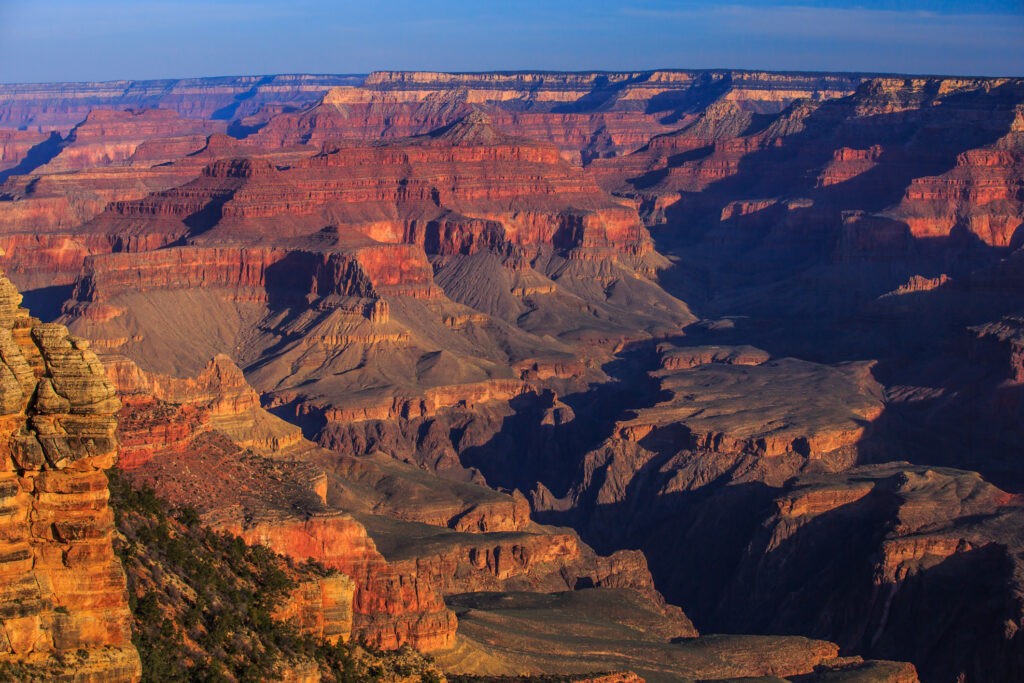
Arizona, known as the “Grand Canyon State,” offers a spectacular stretch of Route 66 characterized by breathtaking natural wonders, iconic landmarks, and a rich cultural heritage.
Famous Landmarks and Natural Wonders in Arizona
- Grand Canyon: One of the most iconic natural wonders in the world, the Grand Canyon is a must-see destination along Route 66. Visitors can explore its vast expanse, hike along its trails, or enjoy panoramic views from the South Rim.
- Meteor Crater: Located near Winslow, Meteor Crater is a massive impact crater created by a meteorite approximately 50,000 years ago. It offers guided tours and a visitor center with exhibits on meteorite impacts and space exploration.
- Sedona: Known for its stunning red rock formations and spiritual vibe, Sedona is a haven for outdoor enthusiasts and New Age seekers alike. Visitors can hike, bike, or take jeep tours to explore its unique landscape and vortex sites.
- Petrified Forest National Park: This park spans both Arizona and New Mexico and features colorful badlands, petrified wood, and ancient petroglyphs. It offers a glimpse into the region’s geological history and prehistoric cultures.
- Hoover Dam: Although not directly on Route 66, Hoover Dam is a short drive from Arizona’s border with Nevada and is a marvel of engineering and a significant landmark in the region.
Impact of Route 66 on Arizona’s Development
Route 66 played a crucial role in Arizona’s development by connecting its remote communities to national markets and facilitating tourism. The route brought economic opportunities to towns along its path, fostering the growth of service stations, motels, diners, and tourist attractions that catered to travelers exploring the American Southwest.
Arizona’s scenic landscapes and natural wonders along Route 66 became magnets for tourists, drawing visitors from across the country eager to experience the Grand Canyon State. The route’s popularity also spurred infrastructure improvements and urban development in cities like Flagstaff, Kingman, and Williams, which became thriving hubs along the route.
Today, Arizona continues to celebrate Route 66’s legacy through preservation efforts, museums, and events that highlight its historical significance and cultural impact. The route remains a symbol of adventure and exploration, offering travelers a nostalgic journey through Arizona’s storied past and majestic landscapes.
California: End of the Road
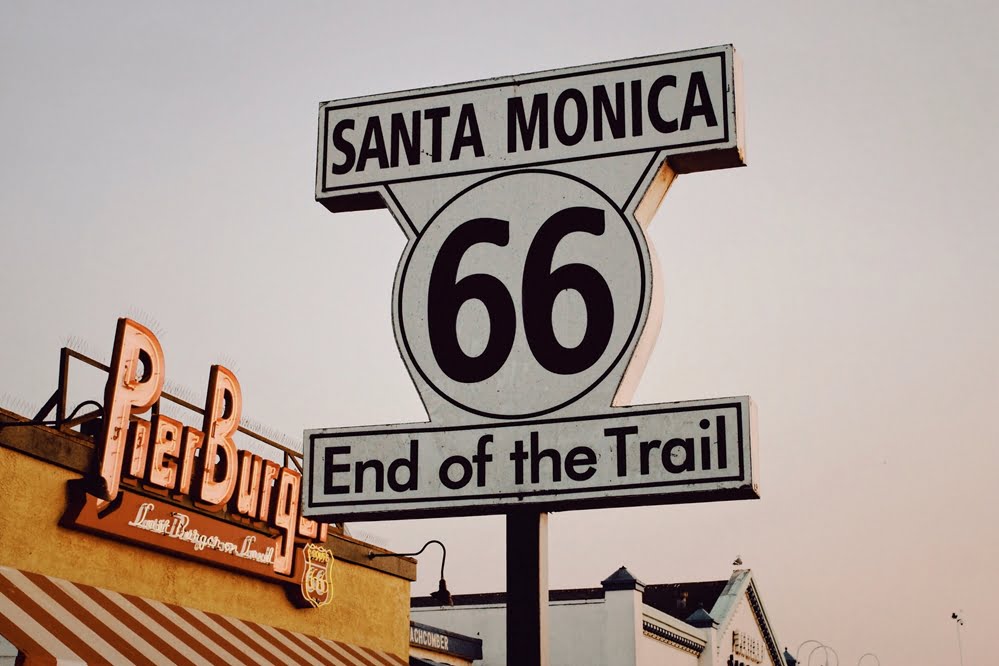
California marks the final leg of Route 66, culminating in Santa Monica, and embodies the allure of the Golden State with its vibrant culture, iconic landmarks, and coastal beauty.
Final Leg of Route 66 Leading to Santa Monica
- Santa Monica Pier: The official western terminus of Route 66, Santa Monica Pier is a historic landmark that welcomes travelers with its amusement park rides, eateries, and Pacific Ocean views.
- Pacific Coast Highway: Route 66 officially ends at the intersection of Santa Monica Boulevard and Ocean Avenue in Santa Monica, where travelers can continue their journey along the scenic Pacific Coast Highway, offering stunning coastal vistas.
- Route 66 End of the Trail Sign: Located at the pier, this sign marks the conclusion of the cross-country journey along Route 66, symbolizing the completion of a historic and iconic American road trip.
Hollywood and the Golden State Connection
- Hollywood: As the entertainment capital of the world, Hollywood is synonymous with glamour, filmmaking, and celebrity culture. Route 66’s proximity to Hollywood made it a popular route for aspiring actors, filmmakers, and tourists seeking a glimpse of the stars.
- Cultural Influence: Route 66 played a significant role in California’s cultural development, linking small towns and urban centers from the Mojave Desert to Los Angeles. The route facilitated the migration of Dust Bowl refugees seeking opportunities in California’s booming agricultural and entertainment industries during the Great Depression.
- Tourism and Legacy: Hollywood’s influence on Route 66 can be seen in its roadside attractions, motels, and diners that catered to travelers eager to experience the allure of the Golden State. Today, California continues to celebrate Route 66’s legacy through preservation efforts, museums, and annual events that pay homage to the route’s historical significance and enduring cultural impact on the West Coast.
Preservation Efforts and Modern Appeal
Preservation efforts for Route 66 have been instrumental in safeguarding its cultural legacy amidst the advancements of modern transportation infrastructure. Organizations, communities, and governments along the route have collaborated to restore iconic landmarks, maintain original roadbeds, and preserve the nostalgic charm of motels, diners, and roadside attractions. These efforts not only ensure that Route 66 remains a tangible link to America’s past but also enhance its appeal to modern-day travelers seeking an authentic road trip experience. Today, Route 66 continues to attract visitors from around the world, drawn by its historical significance, scenic beauty, and the opportunity to explore the diverse landscapes and cultural heritage that define this iconic highway.
Efforts to Preserve Route 66’s Legacy
Route 66, once a vital artery connecting America’s heartland to the West Coast, holds a special place in the nation’s history and culture. Over the decades, there has been a concerted effort to preserve its legacy amidst the evolving landscape of modern highways and urban development.
- Historic Preservation: Various organizations, state governments, and local communities along Route 66 have worked tirelessly to preserve its historic landmarks, buildings, and roadbeds. Efforts include restoring neon signs, revitalizing iconic motels, and maintaining stretches of the original route to ensure future generations can experience its nostalgic charm.
- Route 66 Associations: Non-profit organizations such as the Route 66 Alliance and the National Historic Route 66 Federation have played pivotal roles in advocating for preservation legislation, promoting tourism, and fostering community engagement along the route.
- Cultural Recognition: In 1985, Route 66 was designated a National Scenic Byway, and in 2008, it was designated a National Historic Trail. These designations underscore its cultural significance and commitment to preserving its history for educational and tourism purposes.
Modern-Day Attractions and Nostalgia Tourism
- Roadside Attractions: Modern-day travelers along Route 66 are drawn to a mix of historic landmarks and quirky roadside attractions that pay homage to its heyday. From vintage diners and classic motels to restored gas stations and retro signage, these attractions evoke a sense of nostalgia for mid-20th-century America.
- Events and Festivals: Annual events like the Route 66 International Festival and local celebrations in towns along the route attract thousands of visitors each year. These events showcase live music, car shows, and historical reenactments, celebrating Route 66’s cultural legacy and fostering community pride.
- Nostalgia Tourism: Route 66 has become a bucket-list destination for travelers seeking an authentic Americana experience. Tourists from around the world embark on road trips to drive sections of the route, photograph iconic landmarks, and immerse themselves in its storied past, contributing to local economies and preserving its heritage for future generations.
In conclusion, Route 66’s preservation efforts and modern-day appeal highlight its enduring cultural significance as a symbol of freedom, adventure, and the American spirit of exploration. By preserving its history and promoting tourism, communities along the route ensure that Route 66 continues to captivate and inspire travelers for years to come
Conclusion
Route 66 stands as more than just a historic roadway; it embodies the spirit of American adventure and resilience, leaving an indelible mark on the nation’s cultural landscape. Its enduring legacy is evident in the efforts to preserve its nostalgic charm and celebrate its role in connecting communities from Chicago to Santa Monica. Route 66’s cultural impact is far-reaching, shaping the development of towns and cities along its path and becoming a symbol of freedom and opportunity during pivotal moments in American history.
Route 66’s Enduring Legacy and Cultural Impact
Route 66 stands as more than just a historic highway; it is a cultural icon that embodies the spirit of American adventure and resilience. From its inception in 1926, spanning from Chicago to Santa Monica, Route 66 has been a lifeline, connecting communities and facilitating westward migration during pivotal moments in American history, such as the Dust Bowl era. Its roadside diners, motels adorned with neon signs, and quirky attractions have become symbols of a bygone era, cherished for their nostalgic charm and representation of mid-20th-century Americana.
Reflections on Traveling Through America’s Past
Traveling along Route 66 offers a journey through America’s past, where each mile tells a story of hardship and hope, innovation and tradition. It’s a route that meanders through diverse landscapes—from the urban bustle of Chicago to the deserts of the Southwest—and reflects the changing face of the nation over decades. Driving Route 66 is not just about reaching a destination; it’s about immersing oneself in the cultural tapestry of small-town America, experiencing firsthand the warmth of its people, and marveling at the natural wonders that have captivated travelers for generations. It’s a reminder that the essence of America lies not only in its landmarks but also in the spirit of exploration and discovery that Route 66 continues to inspire.
